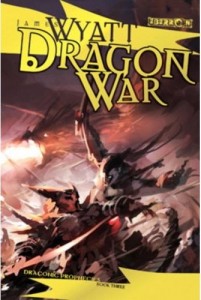Next week I’ll be participating in the Ultimate Dungeon Delve at GenCon. I’ve done my homework and I think I’ve come up with the best possible character for the delve. I’ve only got a few days remaining in which to make tweaks and changes to this PC, so I’m asking you – the readers – to give me your input.
Author: Ameron (Derek Myers)
Review: Dragon War
 Dragon War
Dragon War
(Draconic Prophecies, Book 3)
James Wyatt
An Eberron Novel
Dragon War, the third and final installment in James Wyatt’s Draconic Prophecies comes out today. When I received my copy on Thursday, I couldn’t put it down. It was great.
Although you don’t have to read Storm Dragon and Dragon Forge to understand and enjoy Dragon War, it certainly helps. I enjoyed the other two books in this series a great deal and strongly recommend them to Eberron fans. Both are now available in soft cover.
Month in Review: July 2009
July was a great month month for Dungeon’s Master. We saw our traffic and our readership rise steadily. This was helped in no small part by our early reviews of the July releases from Wizards of the Coast. We welcome the new readers who may have only discovered us in July and thank all of the loyal readers who found us earlier and keep coming back. With all of the great article published in July it’s possible that you might have misses a few. Here are the highlights.
Condition Tracker
As the DM you’ve got a lot of responsibility. You’re accountable for everything that’s not the Player Characters. It’s a tough job. But today we’re making it a little bit easier by giving you a Condition Tracker.
After almost a year we are putting our current campaign on hold, and rather than start something brand new we’ve decided to return to a campaign that we put on hold just before the release of 4e. In many ways going back to a retired campaign can be even more difficult than starting from scratch. As I prepare to put on my DM hat and dust off my old notes I’ve been thinking about all the things I need to do to make this transition run smoothly.
D&D Lego
Just because I’ve seen Star Wars 100 times, does that mean I’m cheating when I play Star Wars Lego? The game follows the plot of each Star Wars movie with incredible accuracy. So does knowing where the game is going give me an unfair advantage? Does my familiarity with the heroes and villains ruin my experience? Not one bit. In fact I bought the games and have enjoyed playing them for EXACTLY that reason.
After playing Star Wars Lego every night for the past week I realized that this familiarity really appeals to me. It doesn’t matter that I know the story backwards and forwards. It doesn’t matter that I know which villain I’m going to face around the next corner. My love for this story and its characters is what brought me to this game and what’s kept me glued to the flat-screen for 50 hours of game play (so far). Upon making this realization my mind immediately started thinking about how to apply this epiphany to D&D.
One of the biggest criticisms I’ve heard about 4e D&D is that the combat takes too long. Sometimes it’s necessary to stop combat, assume the PCs will emerge victorious and keep things moving. When DMs find themselves in a situation where dragging out a combat encounter is just an exercise in rolling dice then it’s time to call the fight. We’ve already shared some of our methods for speeding up your game and as PCs move into the Paragon and Epic tiers of play DMs will find this latest tip more and more useful.
In Find and Repair the Warforged Scout (Part 1) the PCs undertook a mission to scour a battlefield in search of the components of Obsidian, a Warforged scout thought destroyed during the war. Newly discovered information led some to believe that Obsidian was not completely destroyed and that with the right ritual he could be reactivated. If this happens information the scout possesses will be incredibly valuable and potentially damaging to very important people in many different nations.
Setup
Part 2 of the skill challenge begins after the PC recover the missing Warforged components. Now that they have the components they can attempt to put Obsidian back together and try to reactivate him. But this is delicate work that requires a coordinated effort from the entire party.
When a Warforged dies it isn’t always dead. This was especially true during the last war. Just because a Warforged was damaged and fell to the ground during combat didn’t necessarily mean that he was gone forever. It took time for living, breathing commanders to get used to the concept that some of their soldiers were constructs. When retreat was necessary and bodies were left behind on the battlefield, inactive Warforged were often abandoned along with the soon-to-be-rotting corpses. But in some cases the fallen Warforged could still be repaired, if only someone with the appropriate skills made the attempt.
How to Get Your Eberron Fix
Everyone wants more Eberron. Today marks the official release of the Eberron Campaign Guide. If you haven’t yet checked out Eberron in 4e then today is a great time to start. We’ve got reviews of the two core books as well as materials to get a new DM ready for an Eberron campaign. Here are five suggested ways to get your Eberron fix.